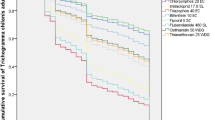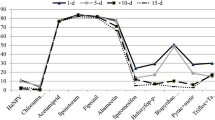Abstract
The insecticide diflubenzuron, Dimilin, was applied topically to the eggs of Tabanus triceps and Chrysops dispar. Mean per cent hatchability of these eggs at various concentrations ranging from 1 to 150 ppm were observed. The hatchability depended upon the age of the egg and increased with age. A minimal dose of 10 ppm of diflubenzuron caused 100% mortality (no hatchability) at the age of 48 hr in both species. The per cent hatchability was inversely proportional to the concentration of Dimilin. The larvicidal effect of Dimilin was also noted. Larval mortality (100%) was observed after 60 hr treatment. The larval mortality was directly proportional to the concentration of Dimilin. The results show that Dimilin has potential for controlling Tabanid vectors.
Résumé
L’insecticide diflubenzuron, le Dimilin a été déposé sur des oeufs de Tabanus triceps et Chrysops dispar. Le taux moyen du pourcentage d’éclosion de ces oeufs à des concentrations variées, allant de 1 à 150 ppm a été observé. La capacité à l’éclosion dépend de l’âge des oeufs et elle augmente à mesure que l’oeuf avance en âge. Une dose minimale de 10 ppm de diflubenzuron cause 100% de mortalité chez des oeufs âgés de 48 heures dans les 2 espéces. Le pourcentage d’eclosion est inversement proportionnel à la concentration de Dimilin. L’effet larvicide est également noté et une mortalité larvaire de 100% est observée après 60 heures de traitement. La mortalité larvaire est directement proportionnelle à la concentration de Dimilin. Les resultats montrent que le Dimilin est un insecticide potentiel, qui peut être utilisé pour contrôler les Tabanides vecteurs.
Similar content being viewed by others
References
Alka Prakash (1992) Ovicidal action of certain chitin synthesis inhibitors in mosquitoes. Entomon. 17: 15–19.
Chokalingam S. and Noorjahan A. (1984) The ovicidal effect of diflubenzuron on hemipteran bugs, Dysdercus cingulatus and Chrysocorispurpureus. Curr. Sci. 53: 1112–1113.
Clarke L., Temple G. H. R. and Vincent J. F. V. (1977) The effects chitin inhibitor—Dimilin—on the production of peritrophic membrane in the locust, Locusta migratoria. J. Insect Physiol. 23: 241–246.
Deul D. H., de Jong B. J. and Kortebach J. A. M. (1978) Inhibition of chitin synthesis by two 1- (2, 6, disubstituted benzoyl)-3-phenylurea insecticides II. Pestic. Biochem. Physio. 8: 98–105.
Hassan A. C. M. and Chanley A.K. (1987) The effect of Dimilin on the ultrastructure of the integument of Manduca sexta. J. Insect Physiol. 33: 667–676.
Ishaaya I. and Casida J. E. (1974) Dietary T. H. 6040 alters composition and enzyme activity of house fly cuticle. Pestic. Biochem. Physiol. 4: 484–490.
Ker R. F. (1977) Investigation of locust cuticle using the insecticide diflubenzuron. J. Insect Physiol. 23: 39–48.
Lacey L. A. and Mulla M. S. (1977) Larvicidal and ovicidal activity of Dimilin (R) against Simulium vittatum. J. Econ. Entomol. 70: 369–373.
Lacey L. A. and Mulla M. S. (1978) Factors affecting diflubenzuron activity against Simulium larvae (Diptera; Simulidae). Mosquito News. 38, (3), 377–381.
Mitsui T., Nobusawa C., Fukami J., Collins J. and Riddiford L. M. (1980) Inhibition of chitin synthesis by diflubenzuron in Manduca sexta. J. Pestic. Sci. 5: 335–341.
Mulder R. and Gijswijt M. J. (1973) The laboratory evaluation of two promising new insecticides which interfere with cuticle deposition. Pestic. Sci. 4: 737–745.
Mulla M. S., Darwazeb H. A. and Norland R. L. (1974) Insect growth regulators: Evaluation procedures and activity against mosquitoes. J. Econ. Entomol. 67: 329–332.
Retnakaran A., Granett J. and Ennis T. (1985) Insect growth regulators. In Comprehensive Insect Physiology, Biochemistry and Pharmacology. (Edited by Kerkut E. A. and Gilbert L. I.) Vol. 12, pp. 529–603, Pergamon Press, New York.
Salama H. S., Motagally Z. A. and Skatullat V. (1976) On the mode of action of Dimilin as a moulting inhibitor in some Lepidopterous insects. Z. Org. Entomol. 80: 396–407.
Schaffer C. H., Wilder W. H. and Mulligan F. S. (1975) A practical evaluation of TH 6040 as a mosquito control agent in California. J. Econ. Entomol. 68: 183–185.
Saxena S. C. and Mathur G. (1981) Suppression of adult emergence on treating eggs of Triholium castaneum (Herbst) by new synthesized disubstituted benzoylphenyl urea compounds. Curr. Sci. 50, 336.
Wright J. E. and Harris R. L. (1976) Ovicidal activity of Thompson-Hayward T.H. 6040 in the stable fly and horn fly after surface contact by adults. J. Econ. Entomol. 69: 728–730.
Wright J. E. and Spates G. E. (1976) Reproductive inhibition activity of the insect growth regulator T.H. 6040 against the stable fly and the horn fly: Effects of hatchability. J. Econ. Entomol. 69: 365–368.
Author information
Authors and Affiliations
Rights and permissions
About this article
Cite this article
Saraswathi, A., Ranganathan, L.S. The Ovicidal and Larvicidal Effect of Dimilin on Tabanus Triceps and Chrysops Dispar (Diptera: Tabanidae). Int J Trop Insect Sci 15, 97–100 (1994). https://doi.org/10.1017/S1742758400016817
Received:
Revised:
Published:
Issue Date:
DOI: https://doi.org/10.1017/S1742758400016817




